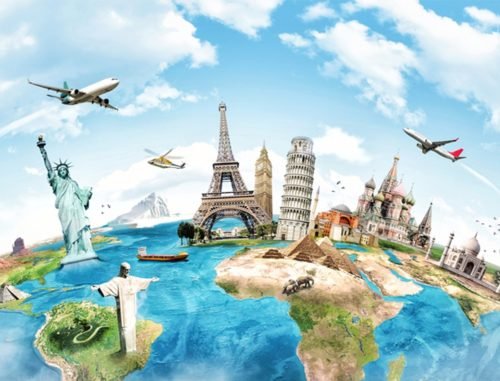✈️ Travel Talk #threadcast
Ep66 Wed 02-Oct-24
ℹ️ This is the #travelcast where we chat all things #travel on Leo
💬 Talk about your trips, discuss adventures and enjoy the world's delights!
- Where have you been, and where would you like to go?
- Post pics/vids, articles, tips, news and anything else related to travel
- Tag #leotravel and join the LeoTravel community
Have fun! 🧳 🛫

From Venice.ai
Information about Santorini, Greece.
History of Santorini
Santorini has a rich and varied history that spans over 4,000 years. The island was first inhabited during the Neolithic period, around 5000 BCE, when farmers settled in the fertile soil and built their first settlements. The Minoans, a advanced civilization, later took control of the island around 3000 BCE. They built impressive palaces, including the famous Akrotiri Palace, which was discovered in 1861.
The Minoans were known for their sophisticated writing system, advanced engineering skills, and beautiful ceramics. They also had a strong navy and traded extensively with other civilizations in the Mediterranean.
However, Santorini's history took a dramatic turn in 1600 BCE, when a massive volcanic eruption destroyed the Minoan civilization. The eruption was so powerful that it destroyed the nearby island of Thira, which was once the Capital of Santorini.
The eruption also had a significant impact on the climate and geography of the island. The volcanic ash and debris blocked out the sun, leading to a prolonged period of cold and darkness. This led to a decline in the island's population and economy.
Architecture and Landscapes
Santorini is famous for its stunning architecture and landscapes. The island's unique geography is characterized by a massive caldera, formed by the volcanic eruption. The caldera is approximately 12 kilometers long and 5 kilometers wide.
The island's architecture is a mix of ancient and modern styles. The old town of Fira, the capital of Santorini, is built on the rim of the caldera and features narrow streets, whitewashed houses, and blue-domed churches. The houses are built into the cliffside, with steep stairs and winding alleys that offer breathtaking views of the caldera.
The island's landscapes are equally stunning. The beaches are white-sand and turquoise, surrounded by towering cliffs and crystal-clear waters. The most famous beach is Red Beach, which is accessible only by boat.
Cuisine
Santorini is famous for its delicious cuisine, which is heavily influenced by Greek and Mediterranean traditions. The island's cuisine is characterized by fresh seafood, Greek salads, and traditional dishes like moussaka and souvlaki.
Some of the island's most famous dishes include:
Wine
Santorini is also famous for its wine, which is produced from the native Assyrtiko grape. The wine is crisp and dry, with flavors of citrus and stone fruits.
Things to Do
Santorini offers a wide range of activities and attractions for visitors. Some of the most popular things to do on the island include:
Accommodation
Santorini has a wide range of accommodation options, from budget-friendly guesthouses to luxurious hotels. Visitors can choose from a variety of styles, including traditional Greek houses, modern apartments, and boutique hotels.
Some of the most popular accommodation options in Santorini include:
Getting There
Santorini is easily accessible by air, with direct flights from many European cities, including Athens, Thessaloniki, and Paris. Visitors can also take a ferry from nearby islands, such as Crete and Rhodes.
Some of the most popular airlines that fly to Santorini include:
Tips and Insights
Some tips and insights to keep in mind when visiting Santorini include:
https://inleo.io/threads/view/adambarratt/re-leothreads-2ghf39fh2
Taking inspiration from @taskmaster4450, I asked Gemini in Google to write an article about Platania in Calabria Italy. My Mom's father and family members emigrated from there to the United States as a young man.
From Venice.ai
Details about Mexico City, its history, culture, and landmarks.
History
Mexico city has a rich and complex history that spans over 500 years. The city was founded in 1521 by the Spanish conquistador Hernán Cortés, who arrived with a small group of soldiers and allied with the Tlaxcalans, a neighboring tribe that had previously fought against the Aztecs. The Aztecs, led by Moctezuma II, had built a vast and powerful empire in the Valley of Mexico, with Tenochtitlán as its capital.
The Spanish conquest of Tenochtitlán was a brutal and devastating event that resulted in the deaths of an estimated 200,000 to 300,000 Aztecs. The city was rebuilt by the Spanish, who renamed it Mexico City and established it as the capital of the Spanish Empire in the Americas.
Over the centuries, Mexico City has been a major center of politics, culture, and commerce in the Americas. It was a key location for the Spanish colonial empire, and many of its landmarks, such as the Cathedral and the Palace of Fine arts, were built during this period.
In the 19th century, Mexico City experienced a period of rapid growth and modernization, driven by the country's independence from Spain and the discovery of oil in the country's North. This period saw the construction of many of the city's modern landmarks, such as the Angel of Independence and the National Palace.
Neighborhoods
Mexico City is divided into 16 delegations, each with its own unique character and charm. Some of the most popular neighborhoods include:
Landmarks
Mexico City is home to a staggering array of landmarks, including:
Cuisine
Mexican cuisine is world-renowned for its bold flavors, vibrant colors, and rich cultural heritage. Some of the city's most famous dishes include:
Culture
Mexico City is a city that pulsates with energy and creativity. From its vibrant street art scene to its world-class museums and galleries, there's always something to explore and discover. Some of the city's most famous cultural events include:
Arts and Culture
Mexico City is a city that is deeply passionate about the arts, and is home to a wide range of museums, galleries, and cultural institutions. Some of the city's most famous arts and cultural events include:
Fashion
Mexico City is a city that is deeply passionate about fashion, and is home to a wide range of fashion designers, boutiques, and fashion events. Some of the city's most famous fashion events include:
Nightlife
Mexico City is a city that knows how to party, and is home to a wide range of nightlife options, from trendy bars and clubs to live music venues and dance halls. Some of the city's most famous nightlife events include:
Shopping
Mexico City is a shopper's paradise, and is home to a wide range of shopping options, from high-end boutiques to bustling markets and flea markets. Some of the city's most famous shopping events include:
https://inleo.io/threads/view/adambarratt/re-leothreads-2wxepwksz
Welcome to the Wednesday TravelCast! Post all your travel shenanigans right here...

Previous edition:
https://inleo.io/threads/view/adambarratt/re-leothreads-pnwbcndt
https://inleo.io/threads/view/nhaji01/re-leothreads-pgskcjq4
Foreign Office issues urgent new travel warning for 17 countries
Article via Express
Where tourists seldom tread, part 12: five more UK towns with hidden histories
Article via The Guardian
Iran attack on Israel sparks flight diversion chaos as Air France passengers endure eight-hour trip to nowhere
Article via Independent
Plan your 2025 adventure with the best travel websites
Article via Luxury Lifestyle Magazine
Blink Parametric and Travel Insurance Saver launch real-time flight delay service
Article via FinTech Global
Dozens of flights diverted as Middle East airspace temporarily closed
Article via Travel Gossip
UK lags international travel recovery but optimism remains
Article via Hospitality Investor
LeoTravel community:
https://inleo.io/communities/hive-190432
https://inleo.io/threads/view/onealfa/re-leothreads-2h22vcdho
https://inleo.io/threads/view/adambarratt/re-leothreads-36vmsadz7
Any upcoming trips planned? Or perhaps recount a past adventure?
‘Vibrant’ and ‘historic’ European capital named the cheapest - beating Athens and Budapest
Let’s take a look at the top 10 most budget-friendly options this autumn...
Article via Express
Platania, Calabria: A Hidden Gem in Southern Italy
Platania is a charming village nestled in the heart of the Aspromonte National Park, Calabria, Italy. This picturesque region, known for its rugged beauty, ancient history, and delicious cuisine, offers a truly unique experience for travelers.
A Glimpse into Platania's History
Platania's origins date back to the Greek colonization of southern Italy. Evidence of this ancient heritage can be found in the local dialect, which still retains Greek influences. The village has witnessed centuries of cultural exchange, with influences from Byzantine, Arab, and Norman civilizations shaping its character.
Exploring the Village
Platania boasts a well-preserved historic center, characterized by narrow cobbled streets, traditional stone houses, and charming piazzas. One of the highlights is the Church of San Nicola, a beautiful Romanesque-style building adorned with intricate carvings and frescoes.
For nature lovers, Platania offers breathtaking scenery. The village is surrounded by lush forests, rolling hills, and majestic mountains. The Aspromonte National Park provides ample opportunities for hiking, trekking, and exploring the region's diverse flora and fauna.
Culinary Delights
Calabrian cuisine is renowned for its simplicity, freshness, and bold flavors. Platania offers a taste of this culinary heritage with its local specialties. Don't miss the opportunity to savor traditional dishes such as 'nduja, a spicy spreadable sausage; suppli, rice croquettes filled with mozzarella and tomato sauce; and filetto di baccalà, crispy cod fillets.
Festivals and Traditions
Platania celebrates a number of festivals throughout the year, offering visitors a chance to experience local culture and traditions. The Feast of San Nicola, held in December, is a particularly vibrant event featuring religious processions, music, and delicious food.
Why Visit Platania?
Authentic Italian Experience: Platania provides a glimpse into traditional Italian life, away from the tourist crowds.
Natural Beauty: The Aspromonte National Park offers stunning scenery for outdoor enthusiasts.
Rich History: The village's ancient origins and cultural influences make it a fascinating destination.
Delicious Cuisine: Experience the flavors of Calabria with local specialties.
Platania is a hidden gem waiting to be discovered. Whether you're seeking a peaceful retreat, a cultural adventure, or a taste of authentic Italian cuisine, this charming village offers something for everyone.
https://inleo.io/threads/view/pele23/re-leothreads-vh9fmte6?referral=pele23
https://inleo.io/threads/view/adambarratt/re-leothreads-2oor3mtgr
🇧🇪
https://inleo.io/threads/view/pele23/re-leothreads-3be4wlrdz?referral=pele23